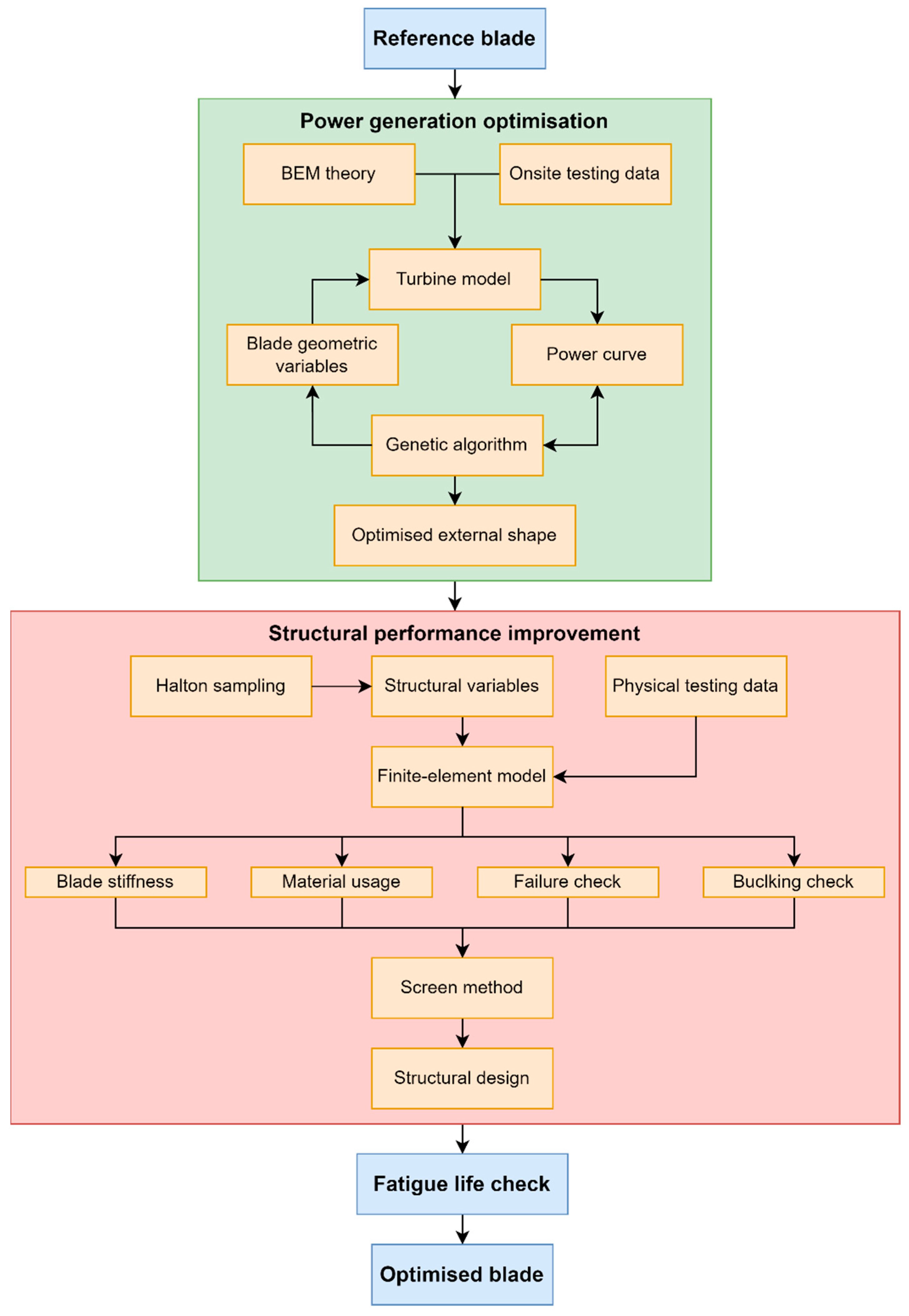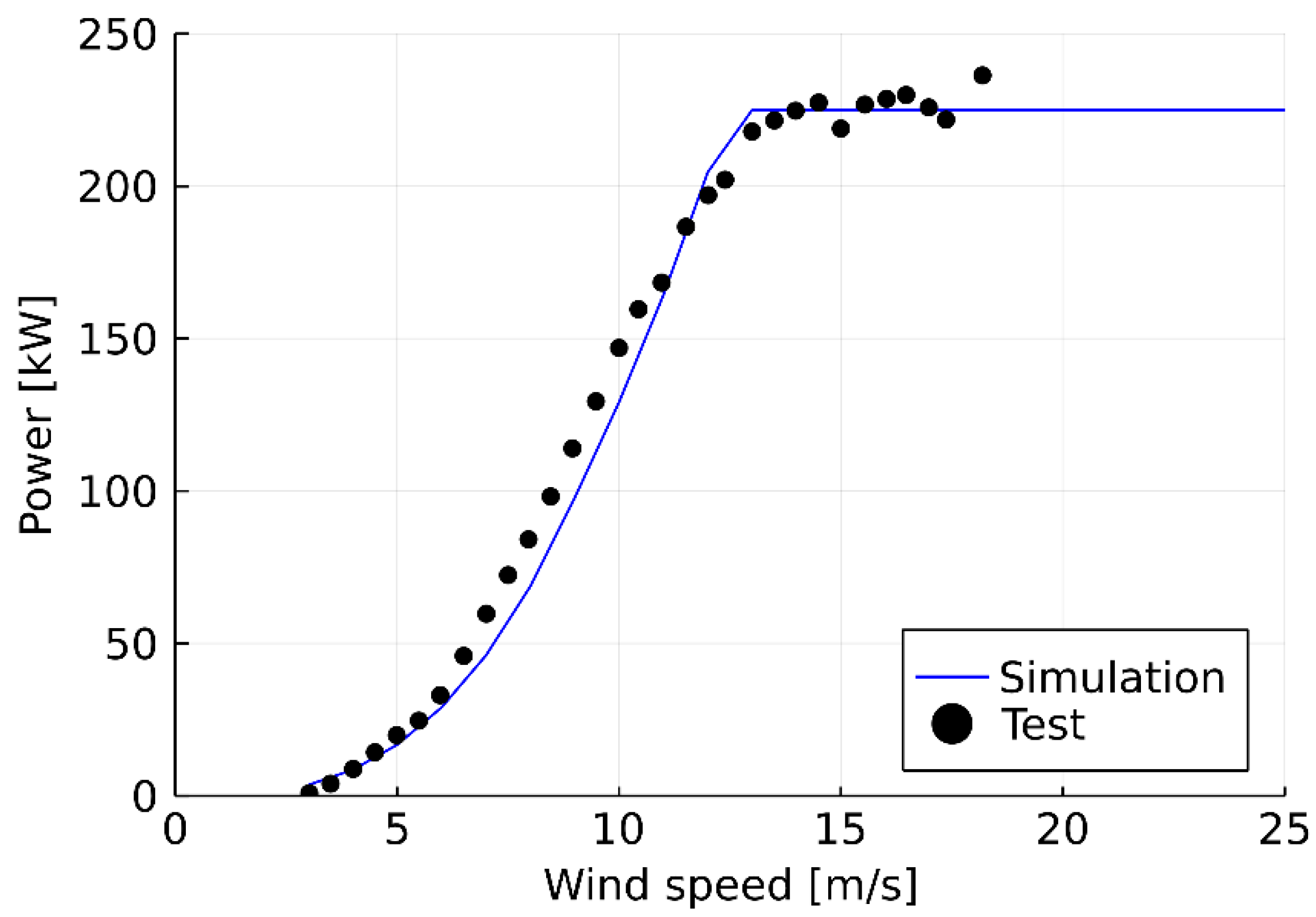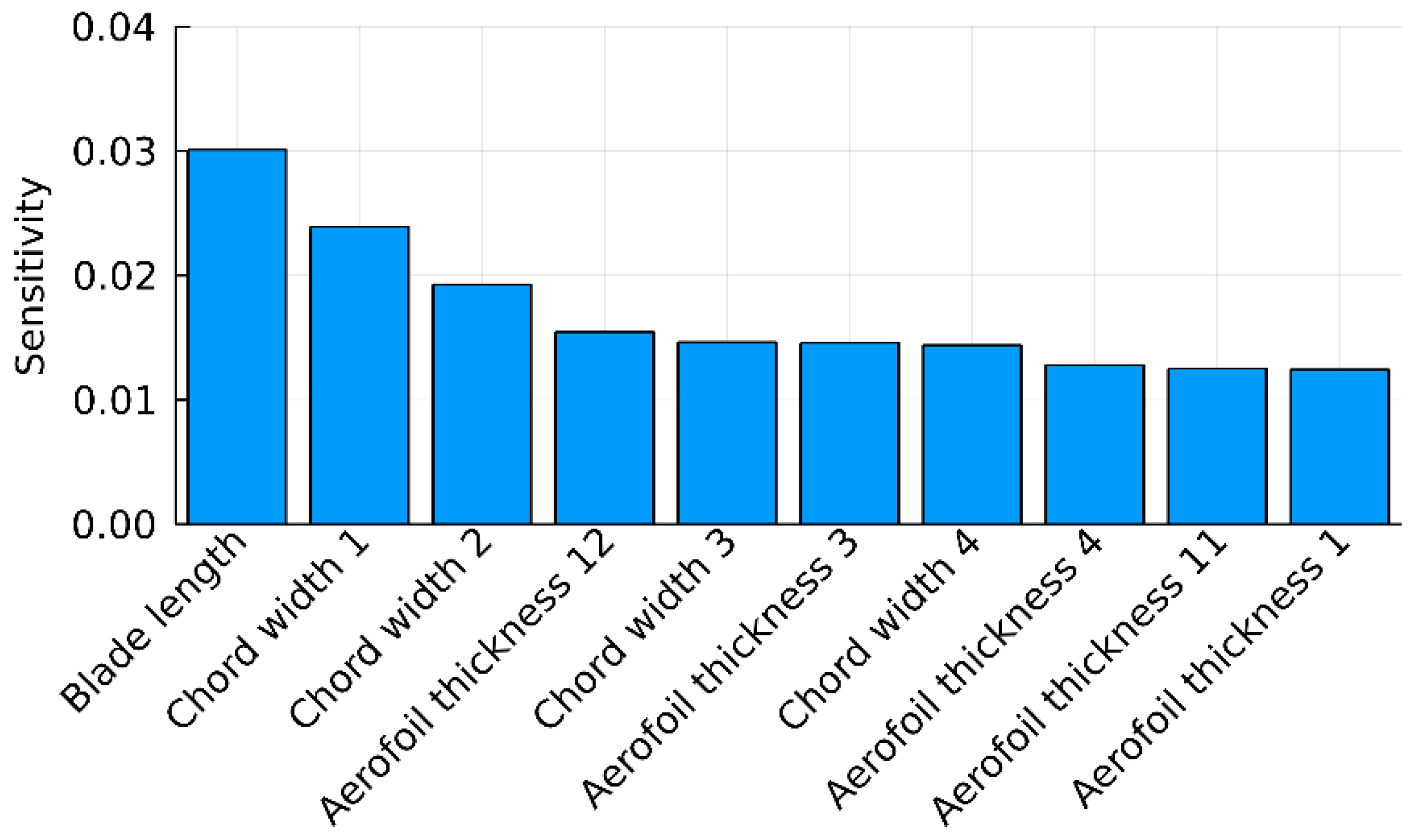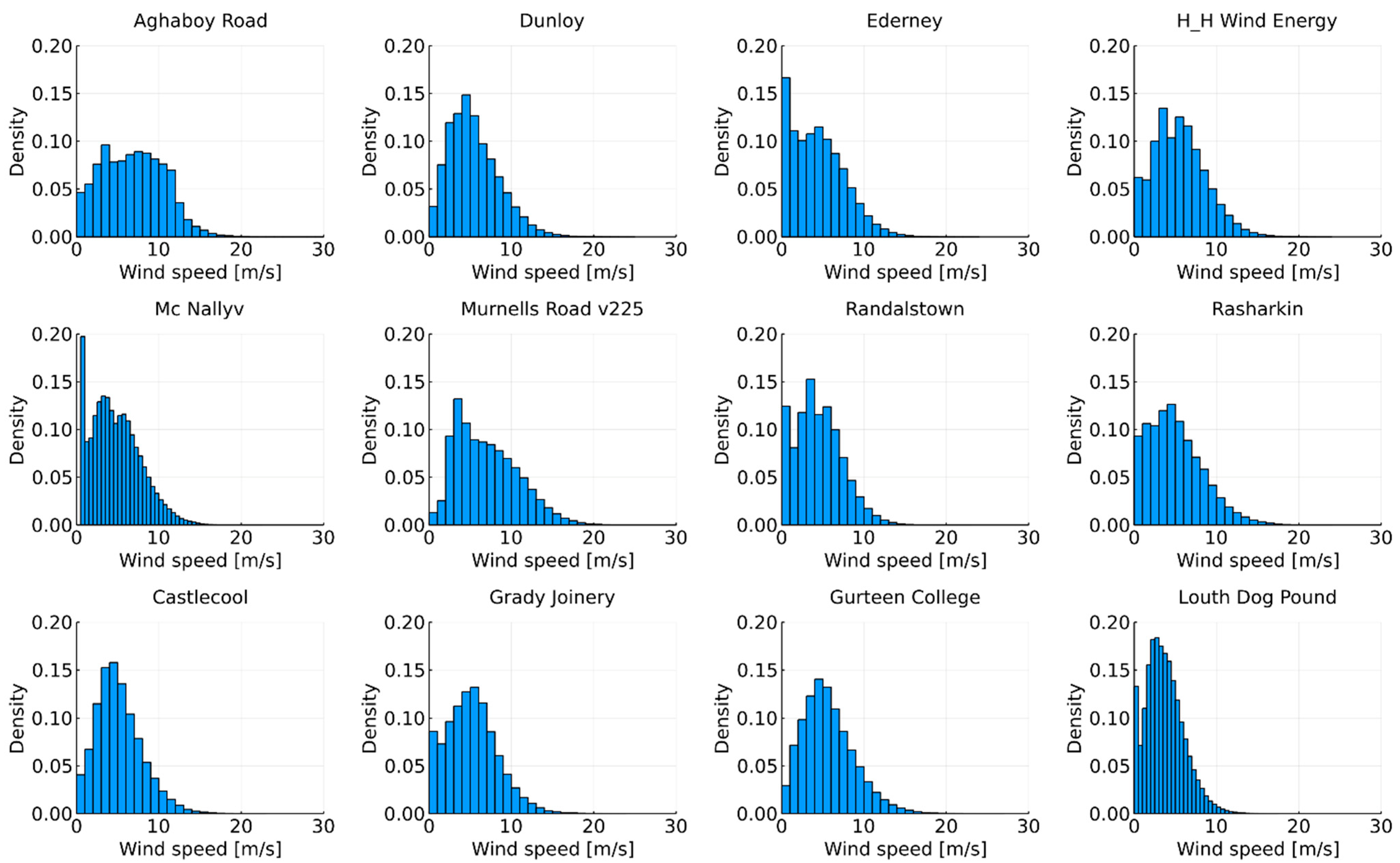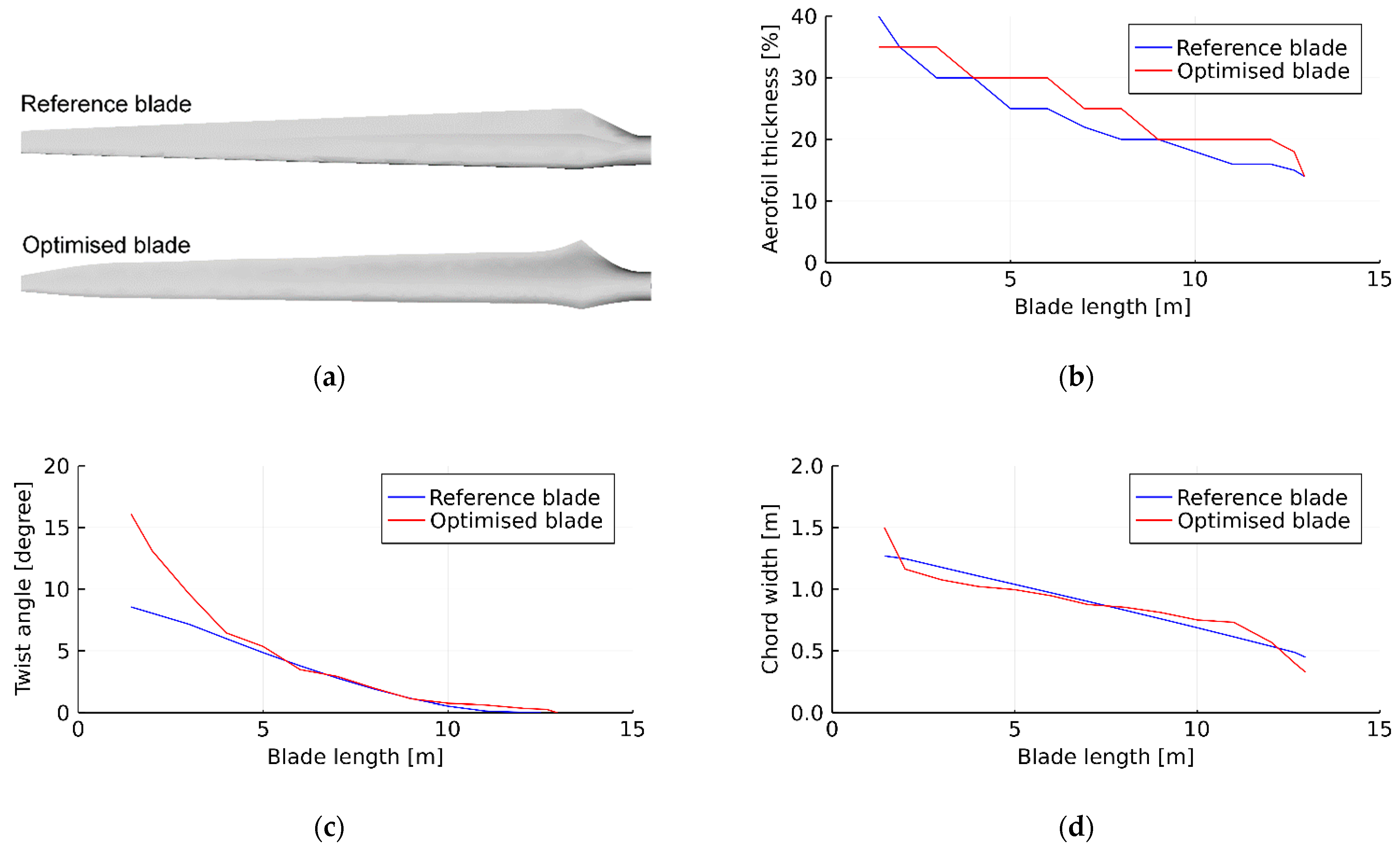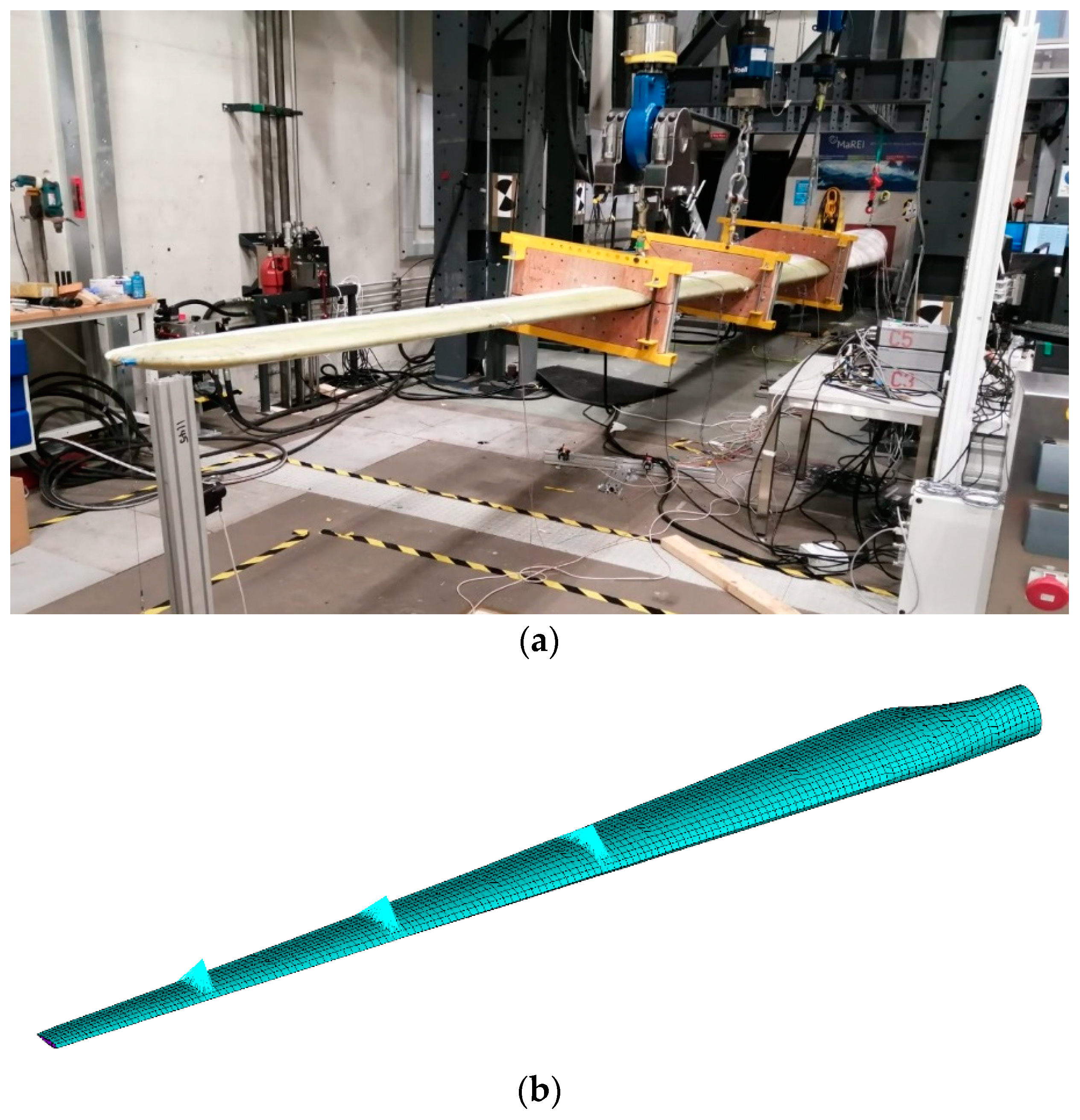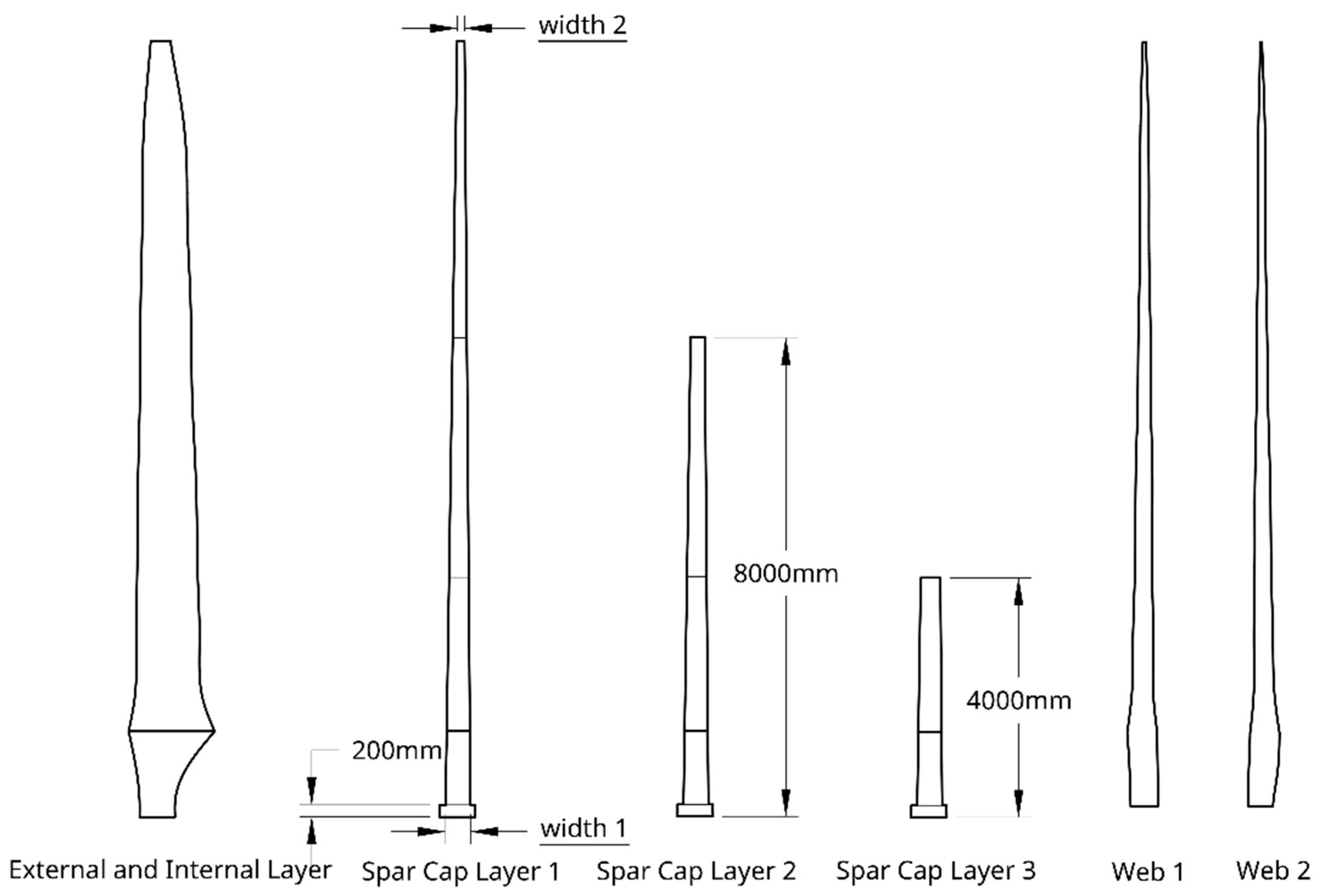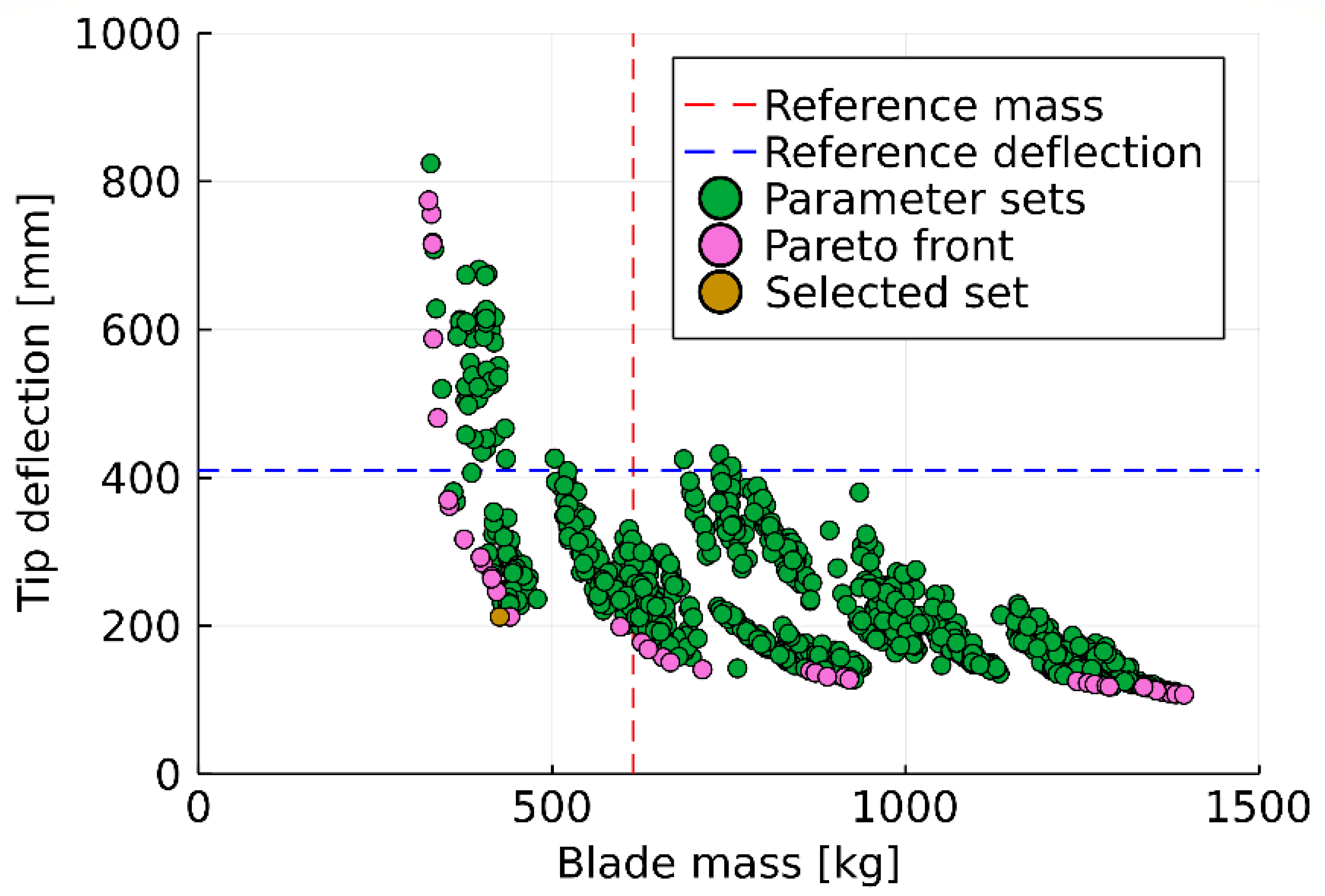1. Introduction
Wind energy is the technology expected to provide the largest contribution to the European Union’s (EU) renewable energy targets for 2020 and beyond. The wind energy capacity could supply up to 24% of electricity demand by 2030, with a total installed capacity of 350 GW [
1]. In recent years, the majority of newly installed wind turbines in EU countries are on a megawatt scale. However, in the early 2000s, the installed wind turbines generally had a capacity of less than 1 MW. Despite the relatively low power production capacity, these turbines can still contribute a nonignorable portion to the total installed wind capacity. For instance, in Ireland, about 17% of the total wind electricity is produced by turbines installed before 2005 [
2]. However, most modern wind turbines are awarded a permitted life of 20 years, indicating that these kilowatt-scale turbines will reach their end-of-life in the near future. Decommissioning and repowering are among the options that can be considered for wind turbines at end of life. Installing new wind turbines with larger capacities extends the life of the wind farm and increases the power production efficiency. However, many of the wind plant sites have restricted planning permission. This means that repowering with larger turbines is not an option. Hence, a viable option to extend the wind farm life can be to retrofit the old turbines with new blades that are within the planning restrictions. Considering that these turbines were designed more than 20 years ago, it is applicable to upgrade their blades with new aerodynamic designs and modern high-strength composite materials to increase power generation while extending the turbine life.
In recent years, many optimisation studies were carried out to improve the aerodynamic performance of wind turbine blades on the basis of the numerical simulation results predicted by blade element momentum (BEM) theory [
3]. Pourrajabian et al. [
4] optimised the geometry of a 1.06 m timber wind turbine blade using a genetic algorithm [
5] with objectives to maximise the power coefficient and minimise the starting time. A discrete optimisation method was utilised by Yang et al. [
6] where the aerodynamic performance and structural response of a 2.1 MW wind turbine blade were optimised. By optimising the airfoil profiles, chord, and twist along the blade, an annual energy production increase of 7.96% was achieved. Aiming to improve the root thrust and reduce blade self-weight, Chen et al. [
7] improved the external geometry of a 78 m long wind turbine blade. To verify the feasibility of the optimisation, a 1/65.3th scaled composite blade was manufactured and tested under a wind generation machine. A nondominated sorting genetic algorithm II-based multi-objective optimisation was applied on a wind turbine blade by Shen et al. [
8], aiming to increase power production and minimise the blade rood flap-wise moment. It was found that, while a 5.87% increase in turbine power generation is accomplished, a 1.48% reduction in hub thrust can be achieved. In addition to the BEM theory, the computational fluid dynamics (CFD)-based wind turbine simulation is an alternative option used in the rotor blade aerodynamic performance optimisation (Li et al. [
9]). To analyse the power generation on a wind farm scale, different methodologies can be utilised. Wang et al. [
10] combined the weather research and forecasting model and the large eddy simulation model to evaluate the performance of wind farms in complex terrain under the actual atmosphere. The predicted nacelle velocity and produced power were found to be in good agreement with the observations. To investigate the diurnal impact of atmospheric stability on wake and power generation efficiency between wind farms, a mesoscale simulated method based on the weather research and forecasting model and wind farm parameterisation can be utilised (Wang et al. [
11]).
In addition to the aerodynamic performance, the blade structural behaviour is also vital to wind turbines to ensure a safe and efficient operation. A simple but effective way of enhancing the blade structural performance is by applying high-strength composite materials during manufacturing. Glass fibre-reinforced polymers (GFRP) are widely used as the primary materials of wind turbine blades. However, in recent years, researchers gradually turned to characterise the mechanical properties of hybrid composite laminates, which combine carbon fibre and glass fibre with polymer resins. According to the experimental tests carried out by Naresh et al. [
12] and Aklilu et al. [
13], hybrid composite laminates were demonstrated to have higher tensile stiffness and strength but lower ultimate strain compared to that of the GFRP laminate. According to the cost analysis from Chen et al. [
14], hybrid laminates containing 50.2% GFRP plies are about 50% less expensive than carbon fibre-reinforced polymers laminates (CFRP), indicating the economic efficiency of this composite material. Since the mixed usage of CFRP and GFRP laminates can lead to benefits in terms of stiffness, strength, and mass, over the last few years, researchers started to design the blade shell as hybrid composites, i.e., to manufacture the spar cap using CFRP while keeping the blade covers and webs as GFRP. Fagan et al. [
15] designed a 15 kW wind turbine blade with CFRP spar cap and twintex covers. Through physical testing, the hybrid blade was proven to have higher stiffness compared to the GFRP blade. National Renewable Energy Laboratory designed a 15 MW offshore reference wind turbine [
16] where the unidirectional laminate CFRP was used in the spar cap to increase the blade stiffness and control the self-weight.
Above and beyond the usage of high-strength composite materials, a proper structural design, i.e., the blade layup details, can also enhance the blade structural performance and reduce material usage. The layup details of a wind turbine blade can be improved through optimisations. By using the infeasibility driven evolutionary algorithm (IDEA) [
17] to optimise the structure of a 30 m wind turbine blade, a mass saving of 7.4% was achieved by Barnes and Morozov [
18]. Another commonly used optimisation method is the genetic algorithm [
5]. Many research works based on this algorithm (Fagan et al. [
19], Jiang et al. [
20], and Fagan et al. [
21]) were carried out to reduce material costs and increase blade stiffness. Sjølund and Lund [
22] optimised the structure of a 73.5 m offshore wind turbine blade. A mass reduction of about 20% was achieved after applying the sequential linear programming method.
However, there are a lack of studies focusing on upgrading existing wind turbines with a highly efficient rotor blade to extend the turbine operation life. While improving the power production of the wind turbine, the wind loads acting on the blade may increase and consequently cause damage to the other components of the turbine. Moreover, the structural performance of the rotor blade, which is critical to ensure the normal operation of wind turbines, is not always considered during the aerodynamic performance optimisation. This can lead to additional work, when designing the blade structure, to complete the whole wind turbine optimisation procedure. Therefore, this research presents a methodology that covers both aerodynamic and structural performance optimisations to propose highly efficient rotor blades, aiming to extend the operation life of existing wind turbines. By optimising the blade external geometry, the power generation efficiency of the blade can be improved. By using high-strength composite materials and a proper layup optimising method, the blade structural performance can be enhanced. In the meantime, the blade root force and moment are controlled to ensure compatibility between the new blade and the hub. This methodology is then applied to a 225 kW wind turbine to verify its feasibility. Physical testing data are introduced to ensure that the simulated results can represent the actual behaviour of the wind turbine. The efficiency of the optimised blade is evaluated by comparing its power generation capacity and structural responses with that of the reference blade. Furthermore, the fatigue life of the optimised blade is analysed to ensure the normal operation of the wind turbine within its lifespan.
5. Conclusions
In this research, a rotor blade upgrade methodology was proposed to extend the operation life of existing turbines. This methodology focuses on optimising the power generation efficiency and structural performance of a wind turbine blade. One of the advantages of utilising this methodology is that not only was the blade external geometry optimised but the geometries and structural details of each blade interior components were also proposed. The optimisation outputs directly provide the blade design with details up to the composite ply level. This enables the manufacturer to build the new blade with just a few additional specifics. Benefiting from the shell-based full-scale blade FE model employed by the methodology, the blade failure risk under multi-axis stress status, calculated on the basis of the advanced composite failure theory, could be included as the optimisation objective. The capacity of rotor connections was included as one of the design constraints, ensuring that the optimised blade was suitable for the existing wind turbine. Moreover, the wind turbine simulation tool and FE model utilised in the optimisation methodology were both validated against physical testing data, which guaranteed the accuracy of the output results.
By applying the methodology, a high-efficiency rotor blade was proposed for extending the operating life of an existing wind turbine, Vestas V27. The accuracy of the numerical models employed to optimise the blade was validated by testing data. By comparing the performance between the optimised blade and the reference blade, it was found to be promising to improve the blade efficiency without changing the blade length. Moreover, with the increase in power production, the shear force and moment can be maintained at the same level as the reference blade by using this methodology. Hence, no additional force was introduced to the hub with the new blades. This ensures compatibility between the optimised blade and the existing turbine hub. By analysing the annual power production of the turbine at 12 different locations, the optimised blade was shown to bring an average improvement of 4.22%, with a power production improvement of approximately 10.5% at a wind speed of 11 m/s. The benefit brought by the optimised blade depends on the wind distribution of the turbine location. A place with a higher average wind speed can have a better power production improvement. The blade structural behaviour, in terms of stiffness, self-weight, failure, and buckling resistance, was improved by using the high-strength carbon fibre composite material and optimising the blade structure. The blade self-weight and tip deflection were proven to reduce by 31% and 48%, respectively. The fatigue life of the proposed new blade was verified to be more than 20 years by simulating the turbine operation under different wind conditions using the aero-elastic analysis. The proposed optimisation methodology was verified to be efficient in generating highly efficient rotor blades for existing wind turbines, in terms of power production and structure performance.
However, there are a number of limitations in applying the proposed methodology. As described in
Section 2.2, there are three steps involved in the methodology, namely, the power production optimisation, structural performance optimisation, and fatigue life check. In the first step, the blade is assumed to be rigid as the structural design is unknown at this stage. Hence, the influence of the blade mechanical properties on wind turbine power production is not considered. Moreover, the blade fatigue life is not considered as an objective during the structural performance. This is due to the complexity of the fatigue analysis since it requires both aerodynamic and structural analyses. Therefore, the aero-elastic-based analysis is conducted in the last step to ensure the fatigue life satisfies the requirement. If the blade fatigue life does not meet the expectation, another blade design should be selected from step 2 and the fatigue analysis should be repeated. This may introduce additional work to the optimisation. Therefore, as part of a future study, a fully coupled aero-elastic analysis will be introduced to the optimisation methodology so that only a single step is required for optimising the rotor blade for life extension of existing wind turbines. This comprehensive, but reliable, optimisation methodology can include the blade fatigue life as a design objective and make it controllable.
